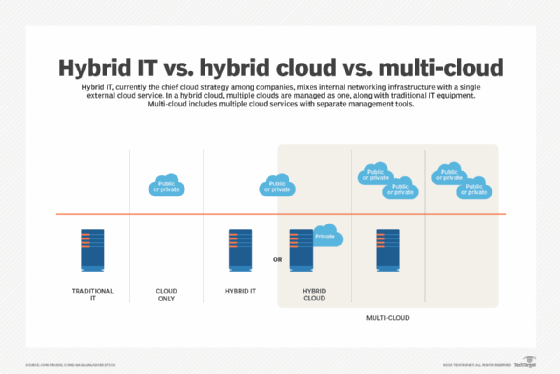What to Expect in 2024 and Beyond

Hybrid cloud infrastructure is evolving rapidly. Businesses are exploring how the new platforms can improve disaster recovery, reduce costs and facilitate the rollout of edge computing, while CIOs struggle with the workload modernization costs required to run more applications in the cloud.
Hybrid cloud tools have new control planes that facilitate better management in the cloud and on premises. Innovations in language-agnostic hybrid cloud tools could further bolster these efforts. CIOs see hybrid cloud’s potential to distribute risks and enable AI and machine learning at scale. AI and automation incorporated in hybrid cloud tools support better monitoring, management, governance and security. These and more trends are directly impacting business operations and shaping the hybrid cloud future.
1. Greater flexibility and control
“A major trend shaping the future of hybrid cloud is the integration of comprehensive control planes into open source projects,” said Taylor Dolezal, head of ecosystem at the Cloud Native Computing Foundation, an open source, vendor-neutral hub for cloud-native computing. These new platforms are ideal for building and running cloud-native applications and provide a flexible and secure way to manage cloud resources in various environments. As enterprises prioritize specialized technologies that cater to their IT team’s unique engineering needs, these control planes can streamline cloud resource management and save time for developers.
It’ll be critical for CIOs to invest in platforms that can balance flexibility and adaptability with control and security. As hybrid cloud environments increase in complexity, enterprises will need to maintain consistent security protocols. They’ll also invest in things like infrastructure as code to ensure application updates, data and infrastructure don’t become siloed. These investments into true control at the infrastructure level will improve the ability to effectively manage complex hybrid environments.
2. Hybrid edge computing on the rise
Enterprises will increasingly deploy hybrid cloud options to optimize latency-sensitive tasks that facilitate integration among edge, public cloud and private cloud environments, predicted Mukesh Ranjan, vice president of cloud and infrastructure at advisory firm Everest Group. “Hybrid infrastructure’s flexibility,” he explained, “empowers businesses to process real-time data, facilitating faster decisions through the distributed model of edge computing.”
CIOs need to view the edge as an extension of data centers. The challenge will be maintaining consistent communication and data integrity between edge devices and the central cloud infrastructure. Investments in edge-to-cloud connectivity and security measures will be one way to meet this challenge. CIOs also will need to evaluate and invest in the right mix of on-premises, cloud and edge infrastructure.
3. Integration of automation, AI and machine learning
Automation and AI in hybrid cloud environments streamline operations, reduce manual errors and optimize resource allocation. Increasing integration of AI and machine learning into hybrid cloud infrastructure will enhance predictive analytics, improve data management and provide better security measures, said Nigel Gibbons, director and senior advisor at cybersecurity consultancy NCC Group. “This trend,” he added, “is leading to more intelligent, self-managing hybrid cloud systems that can predict and adapt to the increased velocity of changing needs.” But integration complexity will be a challenge. Gibbons advised starting with small, manageable projects and gradually scaling up.
4. AI and machine learning at scale
Hybrid cloud architectures, in turn, will fuel the rapid evolution of AI and generative AI, predicted Darrin Alves, CIO of global technical infrastructure at JPMorgan Chase. Distributed multi-cloud models enable organizations to meet the data and compute requirements necessary in training AI and machine learning models and roll them out at scale more efficiently. “Having the ability to operate securely in multiple [cloud] providers,” Alves reasoned, “will allow rapid movement as the landscape changes and providers emerge with different models and offerings.”
5. Generative AI initiatives
Companies will increasingly turn to hybrid cloud models as part of their generative AI initiatives. “One of the leading reasons for the growing hybrid cloud trend stems from the fact that organizations are being pushed to be more innovative in terms of the services and products that they offer,” said Ramesh Vishwanathan, managing director of Google Cloud transformation at consultancy TEKsystems.
Rapidly evolving technologies, like generative AI large language models, can be data-intensive and expensive to build, train and maintain. Rather than build these capabilities in-house, many organizations are investing in cloud services. Yet, transparency, copyright and security issues will revolve around the data being captured, stored and used in training publicly available models. Vishwanathan expects more organizations to adopt hybrid cloud options that include vendor-provided AI services to accelerate research and augment private cloud infrastructure that carries sensitive data, applications and workloads.
6. Language-agnostic, cloud-native apps
There’ll be greater adoption of language-agnostic, open source platforms to simplify the management of cloud applications, Dolezal predicted. These platforms are gaining popularity because of their ability to support diverse application architectures and provide more flexibility for hybrid cloud strategies. On the engineering side, these capabilities address the challenges of integrating platforms into existing infrastructures, while adopting CI/CD and applying best practices to infrastructure-as-code tooling.
“Whether CIOs are looking to make their operations more efficient, launch and scale new applications, or a mix of both, embracing language-agnostic platforms can help their DevOps teams develop and manage applications more efficiently across teams and projects,” Dolezal explained. CIOs will still need to ensure their developer platforms are compatible across cloud services and can handle the complexity of large-scale hybrid cloud deployments.

7. Distributed security risks
Businesses are increasingly exploring the use of hybrid cloud and multi-cloud strategies to improve their cybersecurity risk posture. “With the growing complexity of cybersecurity threats,” Alves said, “operating in more than one cloud helps insulate a company from the concentrated risk of single provider.” He believes ensuring cloud resilience will be a top priority as CIOs advance their digital transformation initiatives and continue investing in hybrid cloud.
8. Cost optimization with more options
CIOs will increasingly benefit from a customized multivendor environment to meet their goals. Finding the right mix of providers and features can help organizations optimize their investments in the cloud. Using Arm processors in servers rather than the current x86 model, for example, can often reduce costs. “With limited choices for on-premises infrastructure,” Alves surmised, “it is easier to do that in the public cloud than it is to do it on prem.”
9. Workload modernization pushback
“The cost of modernizing workloads is a consistent issue for CIOs who recognize the promise of moving to the cloud but lack either the funds, people or knowledge to effectively make the transition,” said Alexander Wurm, senior analyst at advisory firm Nucleus Research. As a result, technology vendors are starting to prioritize a run-anywhere model so businesses can focus on future development in a cloud environment, while maintaining support for existing on-premises workloads. Wurm recommended that CIOs adopt a phased cloud transition strategy, prioritizing cloud-native development to achieve effective and budget-conscious modernization of applications and workloads.
10. Performance-cost balancing act
CIOs will increasingly be tasked with striking the perfect balance in a hybrid application hosting ecosystem to optimize performance and costs. To support diverse application needs, businesses are opting for hybrid cloud environments. Companies are starting to recognize that a one-size-fits-all approach does not suffice, Ranjan said. They’re strategically placing applications where they perform best, whether in the public cloud or legacy ecosystems.
Legacy infrastructures can pose many migration challenges, including time, costs, application performance, technical expertise and potential data loss. The gradual adoption of a new ecosystem can address those concerns. To support this process, enterprises need to embrace a unified view of resources, implement automation for workload deployment, and ensure consistent security and compliance policies across different ecosystems. “Hybrid cloud provides a sense of control,” Ranjan said, “instilling confidence in organizations regarding hardware, compliance and regulations – and cost control.”
George Lawton is a journalist based in London. Over the last 30 years, he has written more than 3,000 stories about computers, communications, knowledge management, business, health and other areas that interest him.



